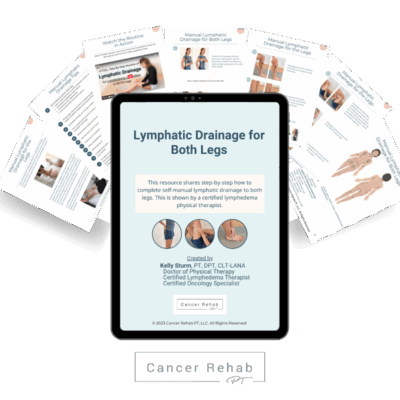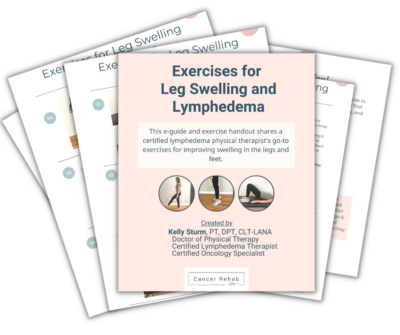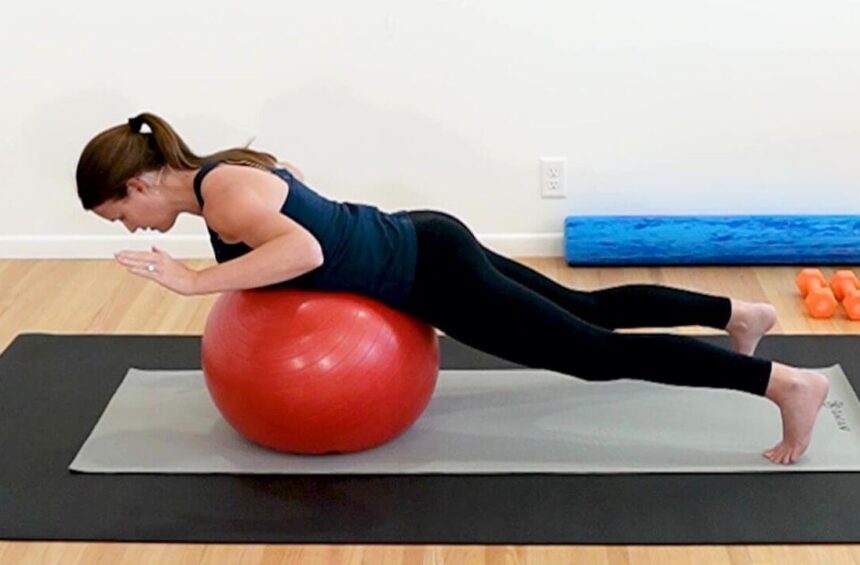Have you noticed your swollen arm or leg starting to feel different lately? Maybe the skin feels thicker, or the area seems harder when you press on it? If you’re dealing with lymphedema, these changes might mean you’re developing fibrosis.
Fibrosis is common with lymphedema, but understanding what’s happening in your body, and catching it early makes a real difference in how you manage it.
Hi, I’m Kelly. I am a certified physical therapist and lymphedema therapist. I specialize in working with those who have lymphedema and those recovering from breast cancer.
What exactly is fibrosis, and how do you avoid getting it if you have swelling or lymphedema? In this guide, I am going to explain what fibrosis is and share the causes, symptoms, and treatment options if you have fibrosis.
What is Fibrosis
Fibrosis happens when your body tries to heal itself, but overdoes it.
Think of it this way: imagine you’re patching a hole in your wall. A little spackle is perfect. Too much? The spot becomes hard, stiff, and raised. That’s basically what’s happening with fibrosis.
When you have lymphedema, fluid builds up because your lymphatic system can’t drain it properly. Your body sees this as a problem and sends repair cells to the area. These cells create fibrous tissue (basically tough, stringy connective tissue) to try to “fix” things. But instead of helping, this extra tissue makes the swelling worse and creates that hard, thick feeling you might notice.
In the case of lymphedema, this happens because the lymphatic system isn’t able to clear out fluid in that part of the body, in the way it should. As swelling occurs, the body sends cells to try to fix this problem. The cells start to make too much tough tissue, which leads to fibrosis.
In my practice, I’ve seen this pattern play out countless times. The key is recognizing it early, when there’s still more we can do to manage it.
Types of Fibrosis
Not all fibrosis develops the same way. Understanding your type helps you and your healthcare team create the right treatment plan. There are several different types of fibrosis.
Lymphostatic Fibrosis
This is the type that develops directly from long-lasting lymphedema. When swelling sticks around too long, fibrosis often follows. This is what I see most often in my patients with chronic lymphedema.
Surgical Fibrosis ( or even fibrosis after liposuction)
Sometimes fibrosis develops as part of your body’s natural healing after surgery – even procedures like liposuction. I’ve treated many breast cancer survivors who develop this type after lymph node removal or breast surgery.
Radiation-Induced Fibrosis
Radiation fibrosis is a condition that develops after someone undergoes radiation therapy, usually for cancer treatment. Radiation therapy can trigger fibrosis months or even years after treatment ends. If you’ve had radiation for cancer treatment, this is something to watch for.
How Fibrosis Changes Lymphedema Progression
Lymphedema is caused by a dysfunction in the lymphatic system, which causes poor lymph flow through the area, leading to congestion and swelling.
Adding fibrosis to lymphedema can further block lymph pathways and exacerbate someone’s symptoms. This is why it is important to manage your lymphedema, which reduces the risk for developing fibrosis.
The Fibrosis-Lymphedema Cycle
Lymphedema already means your lymphatic system isn’t moving fluid the way it should. Add fibrosis into the mix, and you’re dealing with physical blockages that make drainage even harder.
I explain it to my patients this way: imagine trying to water your garden through a hose with kinks in it. The water backs up, pressure builds, and everything gets more congested. That’s what fibrosis does to your lymphatic pathways.
If someone has lymphedema and then develops fibrosis, they may find themselves in a fibrosis-lymphedema cycle, which can look like this:
- Lymphedema causes swelling
- Swelling leads to inflammation
- Inflammation creates fibrosis
- Fibrosis blocks lymph drainage
- More swelling occurs
- The cycle continues
Impact on Lymphedema Stages:
- Stage 0-1: Minimal fibrosis, and swelling can still reverse with treatment
- Stage 2: Fibrosis starts developing, swelling becomes firmer and doesn’t “pit” as easily when you press on it
- Stage 3: Significant fibrosis, with hard tissue changes that are much harder to soften
It is very important to receive medical treatment if you have lymphedema and begin to notice signs of fibrosis, as it is much harder to treat the further it progresses.
Why Early Intervention Matters
Dealing with lymphedema is already challenging on its own. Adding fibrosis causes an extra layer of difficulty and is harder to reverse once established. This is why it is so important to understand how fibrosis works and why it is a problem.
I always encourage someone to reach out to their local healthcare professional or lymphedema therapist for personalized guidance and treatment options.
Signs and Symptoms of Fibrosis
It is important to know the signs and symptoms of fibrosis, so that someone can catch fibrosis in the early stages, to prevent worsening of the condition.
Here are some of the many signs and symptoms of fibrosis:
Texture Changes
- The area feels hard or firm when you touch it
- You might describe it as “woody” or dense
- Your skin doesn’t bounce back like it used to
- The tissue feels thick, almost rubbery
Swelling Changes
Fibrosis makes it harder for the body to get rid of extra fluid, causing an increase in swelling.
- When you press on the swollen area, it doesn’t leave a dent anymore (we call this non-pitting edema)
- Elevating your leg or arm doesn’t reduce the swelling like it used to
- The area feels heavy and full, even when you’re wearing compression
- You’re not seeing the same response to treatments that worked before
Skin Changes
- Your skin looks thicker than it used to
- The texture feels rougher
- You notice color changes—areas might look darker or discolored
- In advanced cases, you might see small bumpy growths (called papillomas)
- Skin folds or creases become deeper and more pronounced
Functional Changes
- Your joints feel stiffer than before
- Bending your arm or leg becomes harder
- Your range of motion decreases
- Simple movements that used to be easy now take more effort
How Quickly Does Fibrosis Develop?
My honest answer that no one loves to hear: it varies from person to person.
Some of my patients develop noticeable fibrosis over months, while others see changes more gradually over years. That’s why day-to-day changes can be hard to spot.
What I recommend to my patients: take photos every month or so. Compare them side by side. This gives you a clearer picture of what’s changing over time.
One pattern I’ve consistently observed: fibrosis develops faster when lymphedema goes untreated or under-treated. This is why I’m so passionate about helping people establish consistent lymphedema self-care routines.
Regular treatment makes a difference:
- Compression therapy helps move fluid and reduces inflammation
- Manual lymphatic drainage encourages proper fluid flow
- Regular exercise such as rebounder workouts or exercises on a vibration plate
You can find more lymphedema self-care education and practical resources in my lower body lymphedema program or breast cancer rehab.
If you do believe you are developing fibrois it is best to reach out to your doctor, as earlier stages are easier to treat.
Fibrosis Treatment Options
The best case scenario for treating fibrosis is to catch it in the early stages and seek treatment from a certified lymphedema therapist who can help you through Complete Decongestive Therapy (CDT) with manual lymphatic drainage, compression, exercise, and skin care.
Specialized Treatments for Fibrotic Tissue
Deep Tissue Work:
This involves myofascial release and gentle breaking down of scar tissue to improve how your tissue moves. I use these techniques regularly to help soften fibrosis and combine it with compression bandaging or garments.
Stretching Programs:
Consistent, gentle stretching maintains your range of motion and prevents joints from getting stiff. I teach my patients daily routines they can do at home – nothing complicated, just 10-15 minutes.
Vibration Therapy:
This is an emerging option with promising (though limited) research. Some patients report that vibration therapy helps soften tissue. I’ve seen positive results in my practice, though we need more studies to fully understand how it works.
When Surgery Might Be Considered:
Surgery for fibrosis is rare and typically reserved for severe, advanced cases where other treatments haven’t provided enough relief. Even after surgery, ongoing therapy is essential.
Surgery options include:
- Debulking procedures (removing excess tissue)
- Liposuction (specific technique)
- Lymph node transfer
If surgery is something you’re considering, talk with your healthcare team about realistic expectations and what recovery looks like.
Final Thoughts
If you have lymphedema, it’s important to practice lymphedema self-care routines to help minimize your symptoms and prevent fibrosis.
Living with fibrosis can be frustrating – I see this with my patients all the time. Your limb feels different, treatment becomes more complex, and it’s one more thing to manage. But here’s what I want you to remember: there are real, effective treatment options available, and you have more control than you might think.
Small, consistent actions add up. Even if you’re dealing with established fibrosis, proper management can prevent further progression and often improve your symptoms.
Frequently Asked Questions
Is lymphedema fibrosis reversible?
Lymphedema fibrosis cannot be completely reversed; however, it can be managed through a variety of treatment options such as Complete Decongestive Therapy, compression therapy, and personalized treatments from a certified lymphedema therapist. The key is starting treatment as early as possible and staying consistent with your care routine.
How to stop lymphedema from progressing?
Based on what I’ve seen in my practice, three things make the biggest difference: wear your compression consistently (this is the most important daily action you can take), stay active with gentle, appropriate exercise to keep your lymphatic system working, and work with a certified lymphedema therapist for professional guidance tailored to your specific situation. Early, consistent action prevents progression better than anything else.
Does compression help fibrosis?
Yes, compression is one of the most effective tools we have. It helps reduce inflammation, supports lymph flow, and can prevent fibrosis from worsening. For existing fibrosis, compression (especially in combination with other CDT techniques) can help soften tissue over time. Just make sure to get properly fitted compression.
Can you get rid of fibrosis without surgery?
In most cases, yes. Early intervention with CDT, compression, manual drainage, and exercise can manage fibrosis effectively without surgery. Surgery is typically only considered when fibrosis is severe and other treatments haven’t provided enough relief. The earlier you start treatment, the better your options for managing fibrosis non-surgically.











